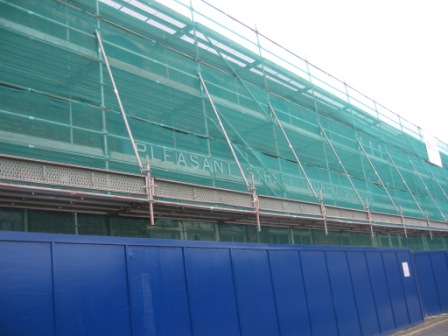|
|
|
|
 |
 |
|
The Benevolent Society of St. Patrick was instituted by influential bankers and merchants of Liverpool. The object was for “the instructing in Reading, Writing, and Arithmetic; the clothing and apprenticing of poor children descended of Irish parents”. The first school was in Bolton Street, Copperas Hill. When the building in Pleasant St was erected, at a cost of £2,681, the master was Patrick BRENNAN. In 1831, Thomas Wyse, M.P described Pleasant St as a model school where “Catholic and Protestant have been there educated perfect harmony together”. Many hoped that such schools would be established as a solution to religious differences.
In 1839, the Corporation offered to take over the school, which by now was declining in numbers. AN emergency meeting was held, which William ROSCOE attended, at which William RATHBONE was appointed President. He retained this position until his death in 1868. The school must have grown again, for a new section for infants was provided in 1851, and in 1852 the school was reorganised into a mixed system. In 1856 Miss MELLY (Florence MELLY, who lived close by on the corner of Chatham St and Oxford St) established a Provident Society.
|
|
 |
 |
 |
 |
 |
|
The 1859 Directory of Liverpool lists Emma KOVACHIC as Mistress and John WILSON as master of the Hibernian Free School, Pleasant St. At this time, the log shows that corporal Punishment had been almost entirely dispensed with in the school, without interfering with the order and discipline. Children were taught Social Economy, the Science of Health, Elements of Chemistry, Carpentry, Tailoring, Simple Elements of Book-keeping, Singing and Drawing. Children could also go to the Swimming Baths. An 1863 inspection reports: ‘order good, dictation on paper and slates considerably above the average. Later that year, however, the celebrations surrounding the marriage of the Prince of Wales to Princess Alexandra caused some problems. All enjoyed the procession through the streets so much that for some days, both staff and pupils were disinclined to work!
An 1864 report states that: “ In this school the teaching is very intelligent. The Master’s fault seems to be that he is a little too easy and good natured, for he has the respect of his pupils and otherwise manages them ell, but allows too much talking.” In 1866 there was still too much noise at times when children were moving around the school, although ‘it is not that there is positive disorder or absolute want of discipline’.
|
|
|
|
In 1866, the name of the school changed to the Hibernian British School. Attendance was very poor. Parts of the neighbourhood (Dukinfield St, for example) were said to be ‘seething in moral corruption’. Once the 1870 Act was passed, the school – and the Board – had more powers to enforce attendance at school. The school transferred to the management of the Board in 1872 and its name changed to Pleasant St Board School.
In 1874 the Welsh Charity School (Bronte St / Russell St) closed, and all the children transferred to Pleasant St, along with the master. Jesse TWEMLOW who was to be head at Pleasant St for 28 years, until his retirement in 1902.
Mr TWEMLOW was exasperated by pupil teachers, one of whom he described as ‘no only lazy and careless, but very dull and stupid – should choose some other calling’. He was particularly concerned by their lack of classroom control. However, things did improve and the 1897 H.M.I. Report stated “This is a well ordered school”.
|
|
|
The school now has its own website. During Liverpool’s Capital of Culture, it will celebrate its 200th anniversary!
|
|
|
 |
 |
 |
|
 |
|
|
In 1902, a new Principal, Mr. George DANIELS was appointed. At that time there were 943 on roll, of whom 49 were Jewish. Mr DANIELS left to go to Webster Rd in 1925. He was replaced by Herbert W STANDRING, from Arnot Street,. At the same time, Miss S. DAWSON was Head Mistress of the Infant. Mr Strandring died in 1934 and was replaced by Mr. E. Campbell ARMOUR, who later went to Lister Drive. A 1938 report stated: It is evident from the neat appearance of the children, heir friendliness, and the bearing of the senior boys and girls that the social training is having good effect. Harry S. DAVIES was appointed new Head Master in 1942. In 1944, Miss RANKIN retired after almost 40 years’ service; Mr DAVIES retired in 1848 when Mr SHIRTCLIFFE became Head. Miss SHAW retired from the Infants’ Department in 1950 after 45 years at the school, and in December 1958 Mrs V GALL who had been Deputy Head for 21 years retired.
During the 1950s there were 2 classes from the Hebrew School (Hope Place) using spare rooms; they will have moved when the King David Schools in Childwall were completed.
Miss L. DEVEREUX, Head of the Nursery, retired in 1967 and died a few weeks later. Mr SHIRTCLIFFE retired in 1860 to be replaced my William POTTAGE., previously of Broad Square CP. He noted in 1960 that since the school moved from Bolton Street to Pleasant Street, about 18 million attendance ticks had been entered in the school’s registers.
Mr POTTAGE worked with Mr DEARDEN to provide these extracts from the school’s early records, for the City Council’s publication ‘Yesterday’s Schools’.
|
|
|

